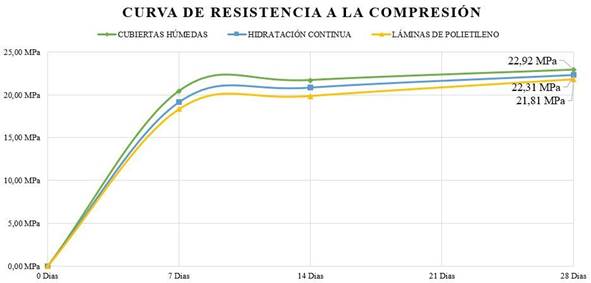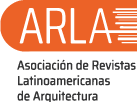Application of curing methods and their influence on the compression strength of concrete
DOI:
https://doi.org/10.51372/gacetatecnica231.4Keywords:
concrete curing, compressive strength, continuous hydration method of concrete, wet concrete cover methodsAbstract
Curing is of vital importance in concrete since it consists of its setting and hardening over time, in order to obtain optimum compressive strength. The objective of this research was to determine the curing method that allows reaching the highest resistance at 28 days. Three different types were used, these are: continuous hydration, wet covers and polyethylene sheets; for each of them, nine cylindrical specimens were made applying the NTE INEN 1576:2011, the compressive strength tests were carried out, applying the NTE INEN 1573:2010, at 7, 14 and 28 days in order to analyze the witness behavior. The design strength was f'c= 21MPa, the compressive strength tests showed that the method with the greatest benefit for the concrete was that of wet cover, reaching a strength value of 22.92 MPa after 28 days with relationship to design f'c.
Downloads
References
C. Manobanda, “El curado del hormigón y su incidencia en las propiedades mecánicas finales”, Tesis BA, Carrera de Ingeniería Civil, Universidad Técnica de Ambato, Ambato, 2013.
MINISTERIO DE DESARROLLO URBANO Y VIVIENDA, “Norma Ecuatoriana de la Construcción (NEC-2015)”, NEC SE HM., Quito, 2015.
NTE INEN 3124:2017-3. Instituto Ecuatoriano de Normalización. “Norma Técnica Ecuatoriana. Hormigón. Elaboración y curado de especímenes de ensayo en el laboratorio”, Quito, 2017.
A. Nilson, “Diseño de estructuras de concreto”, Duodécima ed., Bogota: Mc Graw Hill, 2001.
F. Abanto Castillo, “Tecnología del concreto”, Lima-Perú: Editorial San Marcos, 2009.
L. León y M. Hernández, “Comparación de los valores de resistencia a compresión del hormigón a la edad de 7 y 28 días”, Revista Arquitectura e Ingenieria, vol. 10, nº 1, pp. 1-9, 2016.
M. Sanjuán y S. Chinchón, “Introducción a la fabricación y normalización del cemento Portland”, San Vicente del Raspeig: Universidad d'Alacant: UNE, 2004.
D. Sánchez de Guzmán, “Tecnologia del concreto y del mortero”, Quinta edición, Santafé de Bogota: Bhandar Editores Ltda, 2001.
M. Romo Proaño, “Temas de hormigón armado”, Quito, ESPE, 2008.
NTE INEN 1576:2011, Instituto Ecuatoriano de Normalización, “Norma Técnica Ecuatoriana. Hormigón de cemento hidráulico. Elaboración y curado en obra de especímenes para ensayo”, Quito, 2011.
NTE INEN 1573:2010, Instituto Ecuatoriano de Normalización, “Norma Técnica Ecuatoriana. Hormigón de cemento hidráulico. Determinación de la resistencia a la compresión de especímenes cilíndricos de hormigón de cemento hidráulico”, Quito, 2010.
AMERICAN CONCRETE INSTITUTE (ACI), “Práctica estándar para el curado del concreto”, ACI 308-92, Instituto Mexicano del Cemento y del Concreto, A.C., México, 1994.
V. Villegas, “Ventajas comparativas del curado de concreto con agua vs curado de concreto con productos químicos en la ciudad de Huaraz”, Tesis BA, Escuela de Ingeniería Civil, Universidad Nacional Santiago Antúnez de Mayolo, Huaraz, 2012.
S.L., Tejijut, “Utilización del tejido de yute para el curado del hormigón” Disponible en: https://www.deyute.com/sec/es/news/utilizacion-del-tejido-de-yute-para-el-curado-del-hormigon/40, 2013
Z. Jiménez y D. Ordoñez, “Análisis de la influencia de las técnicas empleadas para el curado de cilindros de concreto hidráulico sobre la resistencia a la compresión”, Tesis BA, Departamento de Civil y Ambiental Barranquilla, Universidad de la Costa, Barranquilla, 2021.
Consejo Provincial de Manabí, “Plan de Desarrollo y Ordenamiento Territorial de Manabí 2015 – 2024 Provincia del Milenio”, 2015.
Megarok S.A, “Megarok S.A”, Dsponible en: http://megarok.com.ec/web/, 2021
NTE INEN 1855-2, Instituto Ecuatoriano de Normalización, “Norma Técnica Ecuatoriana. Hormigones. Hormigón Preparado en Obra. Requisitos”, Quito, 2015.

Published
How to Cite
Issue
Section
Copyright (c) 2022 Luis Daniel Zambrano Navarrete, Ronnie Jefferson Alava Santos, Wilter Enrique Ruíz Párraga, Edgar Antonio Menéndez Menéndez

This work is licensed under a Creative Commons Attribution-NonCommercial-ShareAlike 4.0 International License.
The opinions expressed by the authors do not necessarily reflect the position of the editor of the publication or UCLA. The total or partial reproduction of the texts published here is authorized, provided that the complete source and electronic address of this journal is cited. Authors have the right to use their articles for any purpose as long as it is done nonprofit. The authors can post on the internet or any other media the final approved version of their work.






.png)




